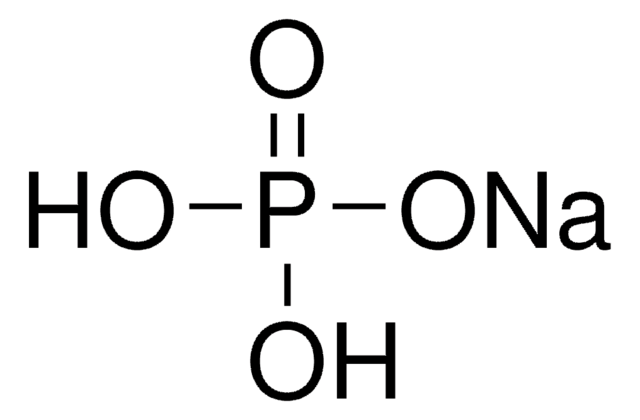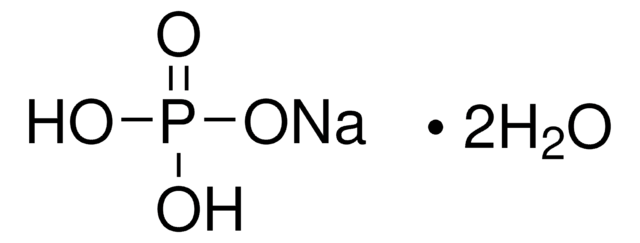S8282
Sodium phosphate monobasic
BioXtra, ≥99.0%
Synonym(s):
Monosodium dihydrogen orthophosphate, Monosodium phosphate, Sodium dihydrogen phosphate
About This Item
Recommended Products
product line
BioXtra
Quality Level
Assay
≥99.0%
form
powder
impurities
≤0.1% Insoluble matter
pH
4.0-6.0 (20 °C, 1 M in H2O)
solubility
H2O: 1 M, clear, colorless
anion traces
chloride (Cl-): ≤0.05%
sulfate (SO42-): ≤0.05%
cation traces
Al: ≤0.005%
Ca: ≤0.01%
Cu: ≤0.0005%
Fe: ≤0.002%
K: ≤0.2%
Mg: ≤0.005%
NH4+: ≤0.05%
Pb: ≤0.001%
Zn: ≤0.0005%
absorption
≤0.2 at 260 in H2O at 1 M
≤0.2 at 280 in H2O at 1 M
SMILES string
[Na+].OP(O)([O-])=O
InChI
1S/Na.H3O4P/c;1-5(2,3)4/h;(H3,1,2,3,4)/q+1;/p-1
InChI key
AJPJDKMHJJGVTQ-UHFFFAOYSA-M
Looking for similar products? Visit Product Comparison Guide
Related Categories
Application
- Evaluation of a Novel Enteral Phosphorus Therapy with Enteral Nutrition during a National Intravenous Sodium Phosphate Shortage.: Sodium phosphate monobasic was evaluated as an enteral phosphorus supplement, offering a viable alternative during intravenous phosphate shortages and improving patient care in clinical nutrition (Harris et al., 2024).
- Two chromatographic methods for determination of cytarabine and dexamethazone; two co-administered drugs for the treatment of leukemia: green analytical perspective.: Sodium phosphate monobasic was utilized as a buffering agent in chromatographic methods, enhancing the green analytical determination of leukemia drugs, contributing to sustainable analytical practices (Magdy et al., 2024).
WGK
WGK 1
Flash Point(F)
Not applicable
Flash Point(C)
Not applicable
Personal Protective Equipment
Choose from one of the most recent versions:
Certificates of Analysis (COA)
Sorry, we don't have COAs for this product available online at this time.
If you need assistance, please contact Customer Support.
Already Own This Product?
Find documentation for the products that you have recently purchased in the Document Library.
Customers Also Viewed
Our team of scientists has experience in all areas of research including Life Science, Material Science, Chemical Synthesis, Chromatography, Analytical and many others.
Contact Technical Service




